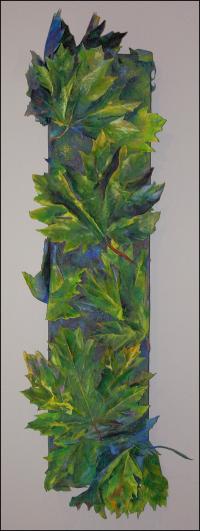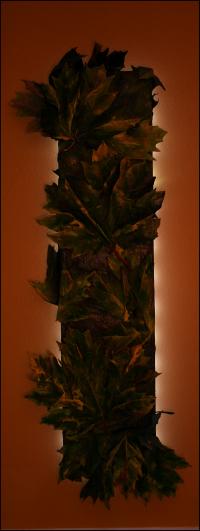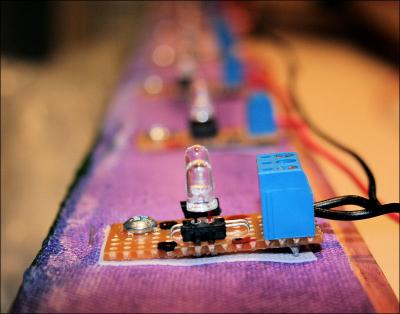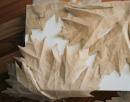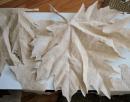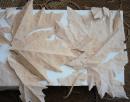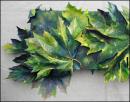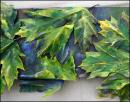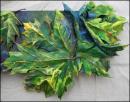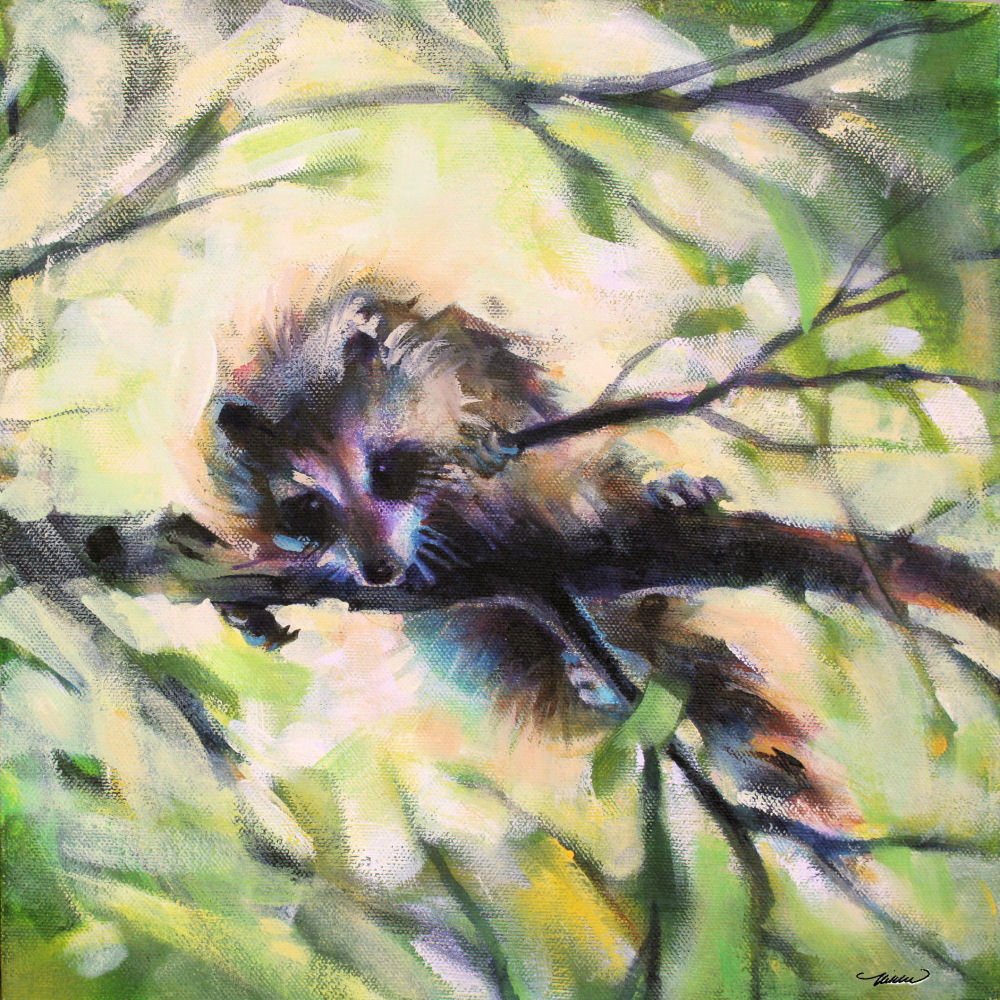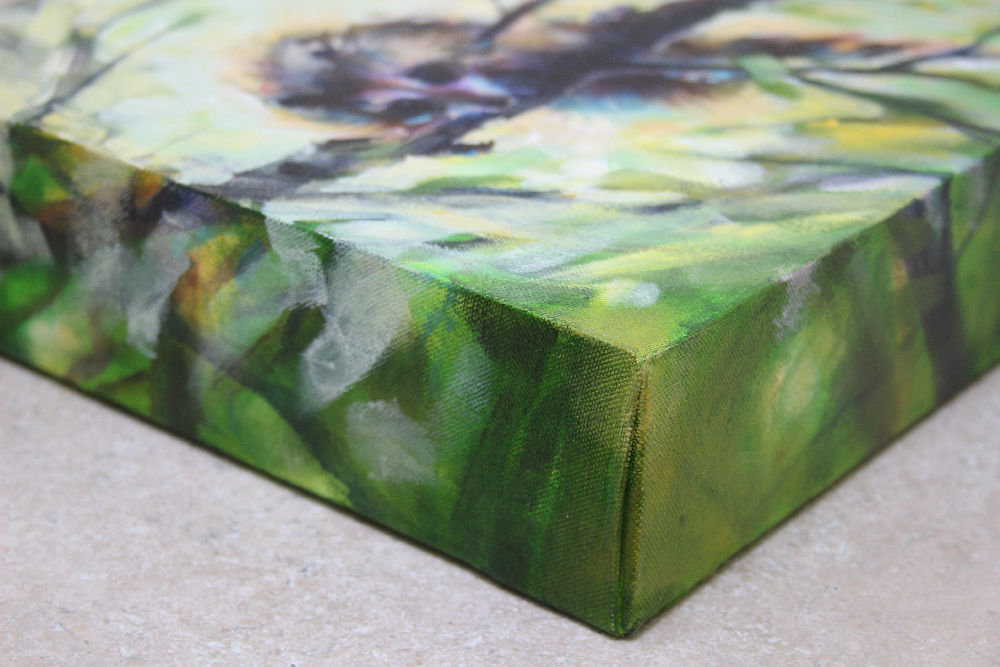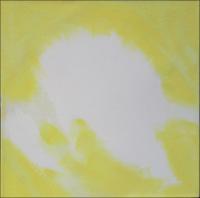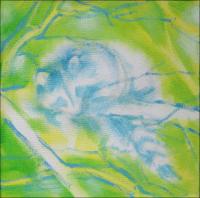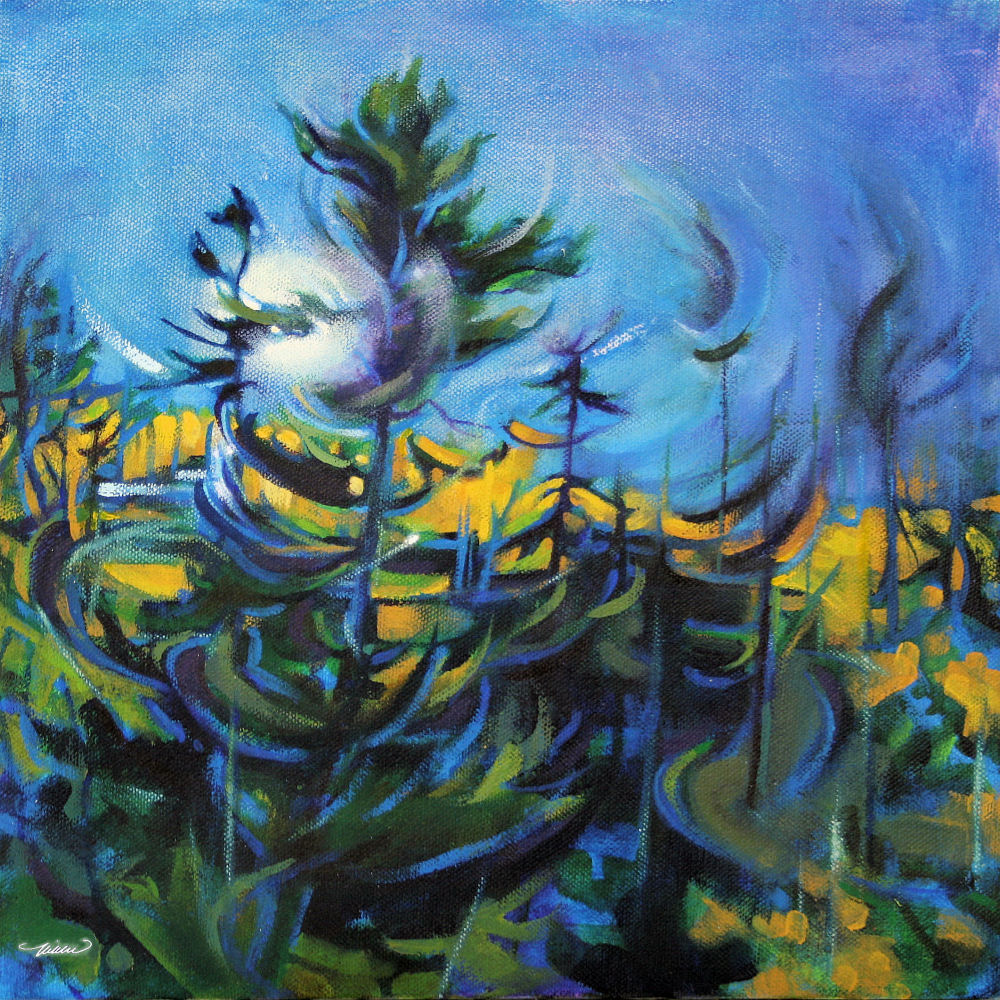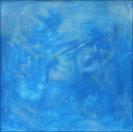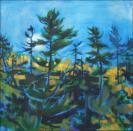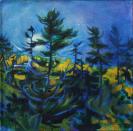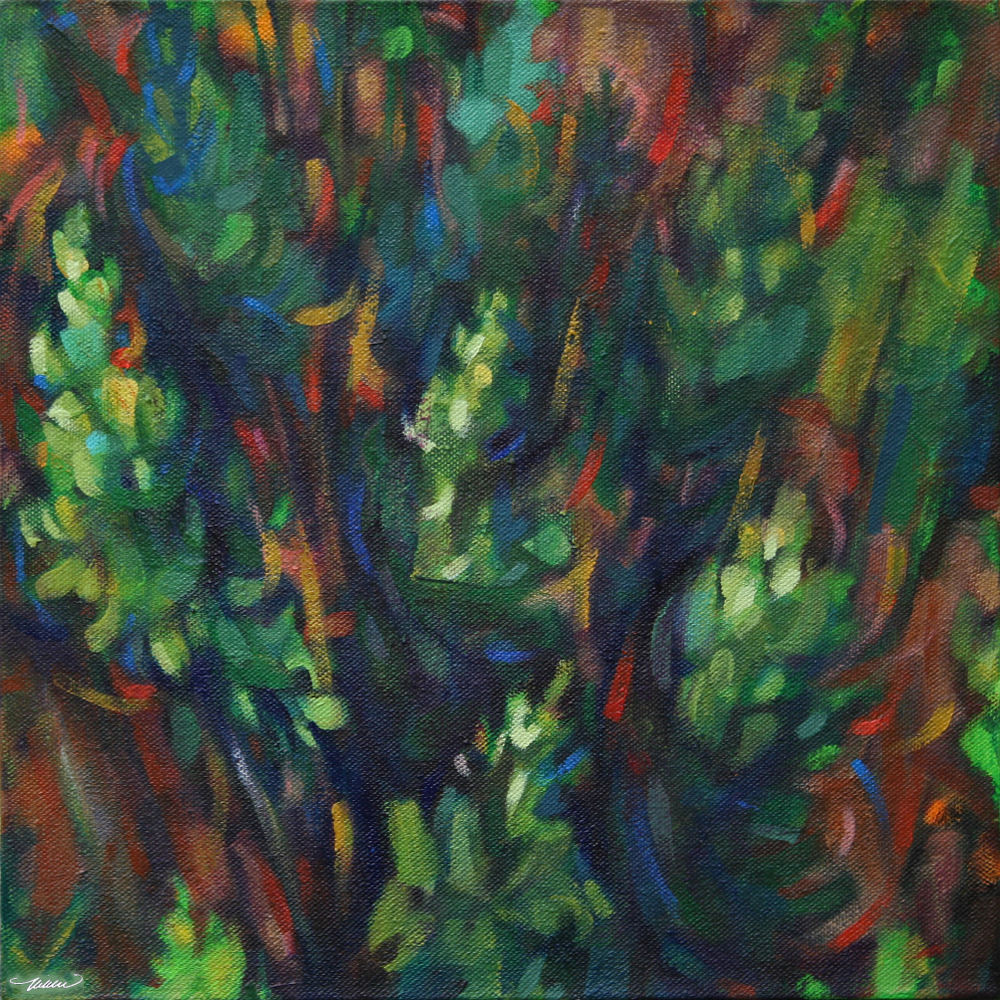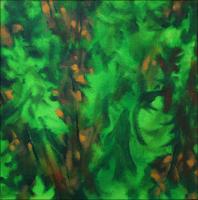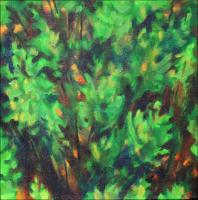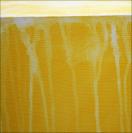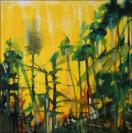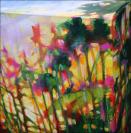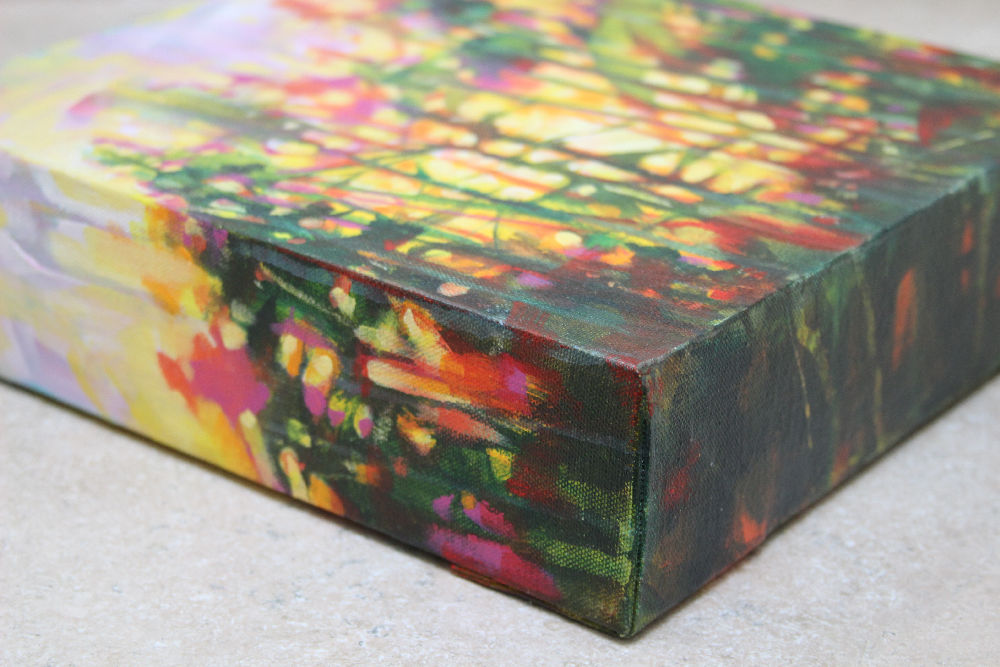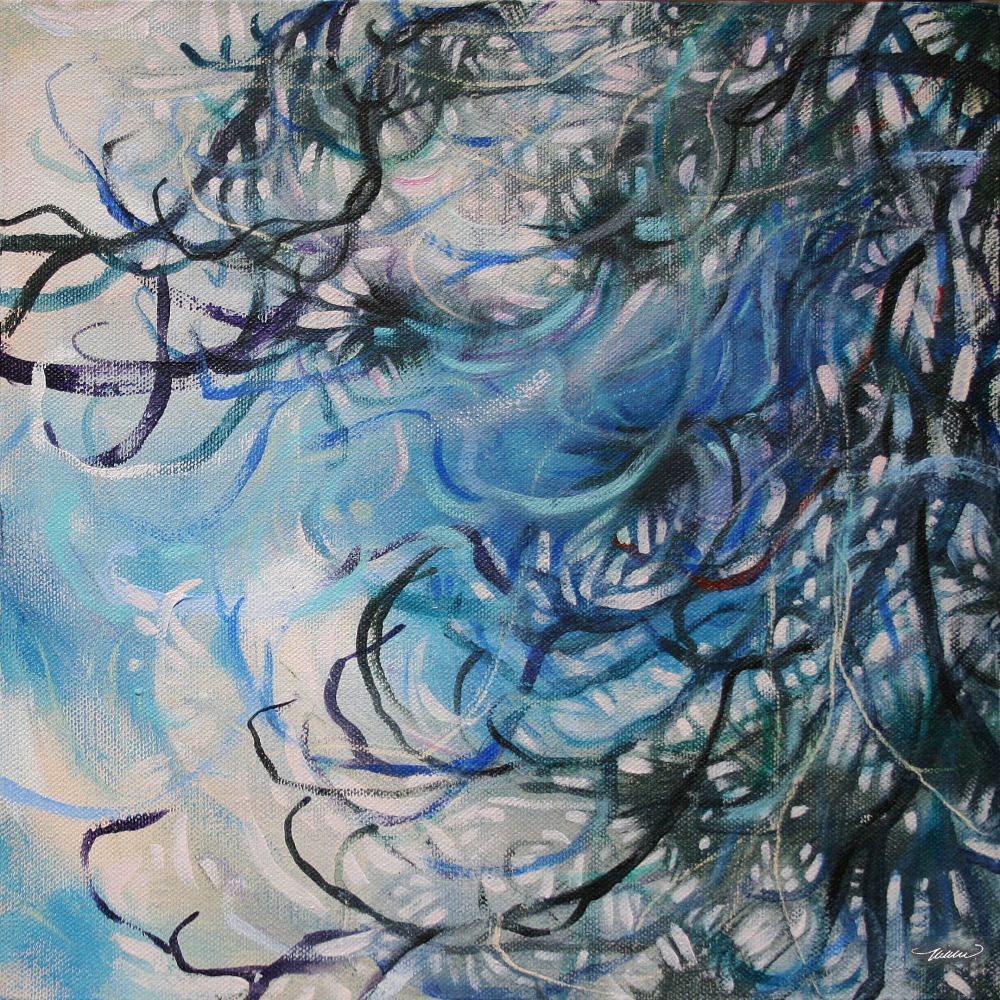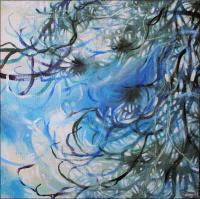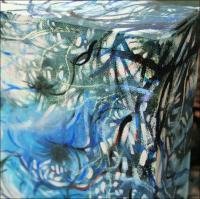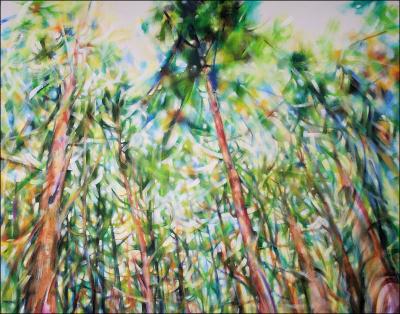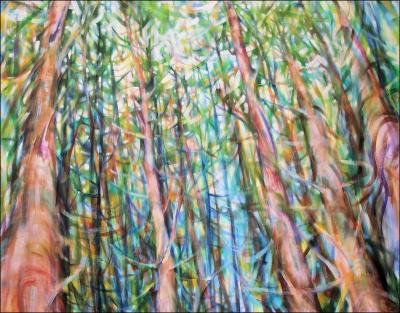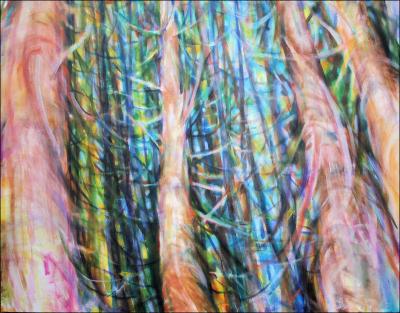Canada
« Previous Entries Next Entries »What Bigleaf Maples Do At Night
Monday, May 25th, 2009
What Bigleaf Maples Do At Night, 57H x 20W x 4D inches muslin, glue, acrylics on canvas wrapped over custom-built stretcher frame. LED light system in back.
Alain, my husband, signed his name on this also, because he spent the entire week designing, soldering and wiring a system of 30 LED lights for the back. He was not impressed with the eight inadequate push-lights I was initially going to use to create this Day- Night Art. The electric source is a rechargeable 12 volt battery placed neatly in the back, with an easily accessible on-off switch in the lower left corner. He’s not thrilled to ever create another, so it looks like I’ll be learning a little about soldering and electronics, because there are plans to transform the other two canvases exactly the same size as this one. Originally l hoped it could hang in any of four orientations, but that was revised due the battery pack in the back. Thank you Alain for making this piece what it is!
______________________The original blog posts; process:___________________
Nov. 17th, 2008: While finishing the final stages of Sun Shower #4, at this point more study than stroke, I’ve started on the next piece… a bit of mystery thrown into this one just for fun. Hint: Step 1 – Unbleached muslin is painted with glue; place over top parchment paper and turn or lift frequently so it doesn’t stick. Nov. 18th: Step 2– When dry the muslin becomes stiff and can be crumpled, pinched and maneuvered to create 3D textures.
Nov 18th, aft. Step 3 – OK, enough guessing. I have three beautiful sturdy 36 x 12 x 3 inch canvases, hung vertically or horizontally. Each one will have a 3D design of life-sized leaves created with the stiff muslin. This one is of Large Leaf Maples seen on salt Spring Island, B.C. when we were there last summer. They are really this big – about 15 inches across! On these canvases, all dimensional surfaces will be considered; the front, the sides, and possibly some sticking out from the back. Everything will be primed before painting and I love Virginia’s idea to use glue as a resist for the leaf veins. In the above three images the design is still in planning stages.
Nov. 19th – A few thoughts before continuing work: this could be as simple as a sillhouette or painted realistically, still haven’t decided..maybe a compromise of the two, on the abstract side of things. Putting lights in the back could be interesting too, as in the recent Zen Garden #8 but would like to come up with something that does not have a distracting cord.
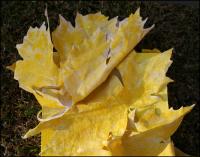 Nov.21st – Seen here, the leaves have a splotchy base coat of Hansa Yellow Deep, a color chosen because when it is so vibrant when it peeks through built up layers of other colors. Now that the entire piece has color though, I think I prefer the sculptural purity of the unpainted sillhouettes better – something to remember for similar work in the future.
Nov.21st – Seen here, the leaves have a splotchy base coat of Hansa Yellow Deep, a color chosen because when it is so vibrant when it peeks through built up layers of other colors. Now that the entire piece has color though, I think I prefer the sculptural purity of the unpainted sillhouettes better – something to remember for similar work in the future.
The weight of tinted primer and each application of acrylics makes the fabric limp from of the paint, meaning the creasing process needs to be done all over again once it dries, even on successive layers. Because of this I need to slow down and be more gentle with the painting process also. It’s funny how you can overlook things like that when you are ten steps ahead with anticipation for a new project; things always take much longer than you imagine. There is going to be a lot of stopping and starting with this one, which is exactly how overlapping projects occurs.
Also: looking forward to a day-long workshop tomorrow, learning about Encaustic painting with Deanna Wood. Encaustics is an ancient process of painting with beeswax and natural resins. Not usually a “workshop” kind of Artist because I’m too greedy with my work-time, but this is one of those things that’s best learned from an expert. Am bringing a fabric leaf to the class to see how it could be incorporated and if this entire. Large Leaf Maples piece could benefit.
______________________________
All posts and comments for this piece are now combined.
Submitted on 2008/11/18 at 11:48am
If you don’t want to see the seed bits in the muslin, you can get unbleached muslin without the seeds.
_______________________________
Submitted on 2008/11/18 at 1:03pm
OK Lynda, thanks for offering this valuable tip. With regard to what’s in mind for this project, the rawness of the fabric will provide extra texture, but others may want to know that finer quality muslin is available.
Nikki
_______________________________
Submitted on 2008/11/18 at 1:53pm
Hmmm…looks like a resist process to me. Is it a mask? You are a very adventurous soul!
Virginia Wieringa
_______________________________
Submitted on 2008/11/18 at 2:06pm
Nope, not a mask or resist…at least the glue wasn’t initially going to be used as a resist, but once again I owe thanks for the tip via a viewer’s comment – thanks Virginia! It’s true, glue can be used on anything as a paint resist, usually on wood it works similar to crackle glaze (ask me how if anyone is interested). I haven’t tried that technique on raw fabric yet though and for what I have in mind, painting extra glue in strategic places could produce some interesting effects. Let’s see…
Nikki
_______________________________
Submitted on 2008/11/19 at 1:16am
This is great Nikki. I’ll be back tomorrow to see how this project is coming along.
Jim Drury
_______________________________
Submitted on 2008/11/19 at 4:12pm
Hi Nikki
This is getting really interesting, can’t wait to see the finish project
Elizabeth
_______________________________
Submitted on 2008/11/19 at 7:07pm
Thanks for staying tuned Dad and Elizabeth, I also can’t wait to see the finished project – it’s always a mystery even if I think I know what I’m doing.
Nikki
_______________________________
Nov.27: What Large Leaf Maples Do At Night, detail images of 12 x 36 x 3 inches Muslin, glue, acrylics on wrapped canvas. As seen here I imagined the leaves glowing in the moonlight, which took me to the idea of turning it into a piece that can be viewed differently in a dark corner or at night so the sculptural sillhouette shows best.
Since Saturday’s Encaustics workshop I’d like to try another sculptural piece doing the whole thing with 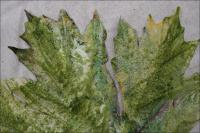 Encaustics tecniques, see right sample. Beeswax doesn’t adhere to acrylics though, so another will need to be planned with that medium in mind right from the start.
Encaustics tecniques, see right sample. Beeswax doesn’t adhere to acrylics though, so another will need to be planned with that medium in mind right from the start.
The Visitor: Raccoon
Thursday, March 5th, 2009
The Visitor: Raccoon, 11H x 11W x 3D inches acrylics on canvas, sides painted. Frame unnecessary. Hang on a wall or display on a flat surface.
Progress and process details:
Jone’s Falls
Tuesday, March 3rd, 2009
Jone’s Falls, near Thousand Islands, Southern Ontario, 11H x 11W x 3D inches acrylics on canvas, wrapped sides painted. Frame unnecessary. Hang on a wall or display on a flat surface.
Sold.
Some barely noticeable lines were scratched on wet paint here and there, and they break up the space into sections now, if you compare the 3rd thumbnail and the finished piece.
Bird’s Eye
Saturday, February 28th, 2009
Bird’s Eye, Banff, Alberta, Canada, 11H x 11W x 3D inches acrylics on canvas, wrapped sides painted. Frame unnecessary. Hang on a wall or display on a flat surface. Signed on the side so as not to impose on the composition.
Progress thumbnail images below:
St. Catharine’s Sunset
Friday, February 27th, 2009
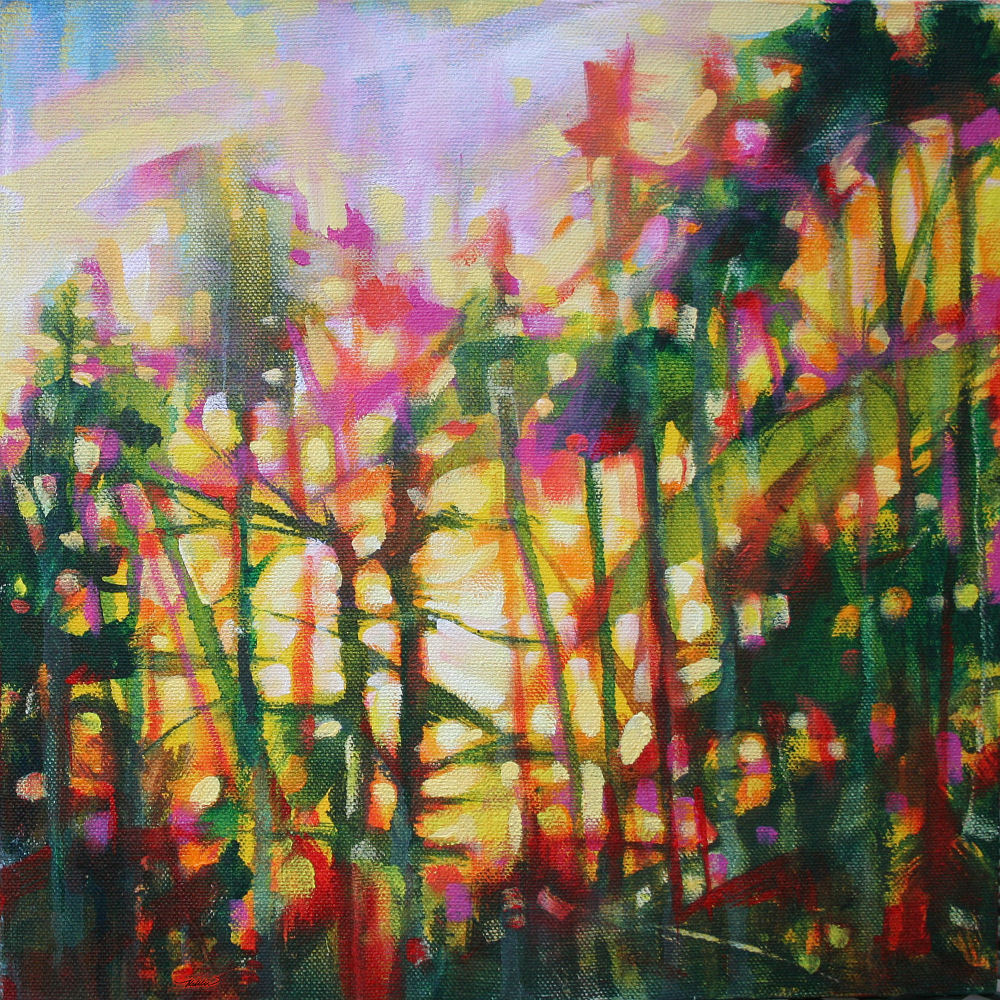
St. Catharine’s Sunset Ontario, Canada just north of Niagara Falls, 11H x 11W x 3D inches acrylics on canvas, wrapped sides painted. Frame unnecessary. Hang on a wall or display on a flat surface. Signed on the side so as not to impose on the composition.
There is no one method for starting a painting. When faced with a blank white surface, sometimes our mind can go blank too. When that happens I use a base color that inspires energy. Here, water and paint were dripped down a wet surface of Hansa Yellow Deep. Painting intuitively with a wide raggedy old brush, the fraying bristles are used to advantage, and those marks direct how the painting proceeds.
This painting is dedicated to my Mom, born in St. Catherine’s, Ontario, Canada whose birthday was two days ago.
Jack Pine
Wednesday, February 25th, 2009
Jack Pine, 11H x 11W x 3D inches acrylics on canvas and detail of right side; wrapped sides painted. Signature is on the side, so one is superimposed here on the front. Hang on a wall or display on a flat surface.
Dancing With Trees 03
Thursday, February 19th, 2009
Dancing With Trees 03, 85H x 45W x 3D inches acrylics on canvas, wrapped sides painted, trim frame. Signature piece for the Dancing With Trees exhibition, formerly entitled ‘The Majesty of Trees’. There is no black in this painting; the darkest areas are dioxazine purple. Aside from a couple of areas that are still questionable this painting is now finished. Specifically: I’m not sure about adding shadows and contrast on the bark of the main trees because it may take away from the cheerful expression of colors.
Progress in previous posts: January 19th and 30th
The name of the exhibition changed to ‘Dancing With Trees’ to avoid plagiarizing the title of a book, ‘The Majesty of Trees’.
End of Tulip Season
Wednesday, February 18th, 2009
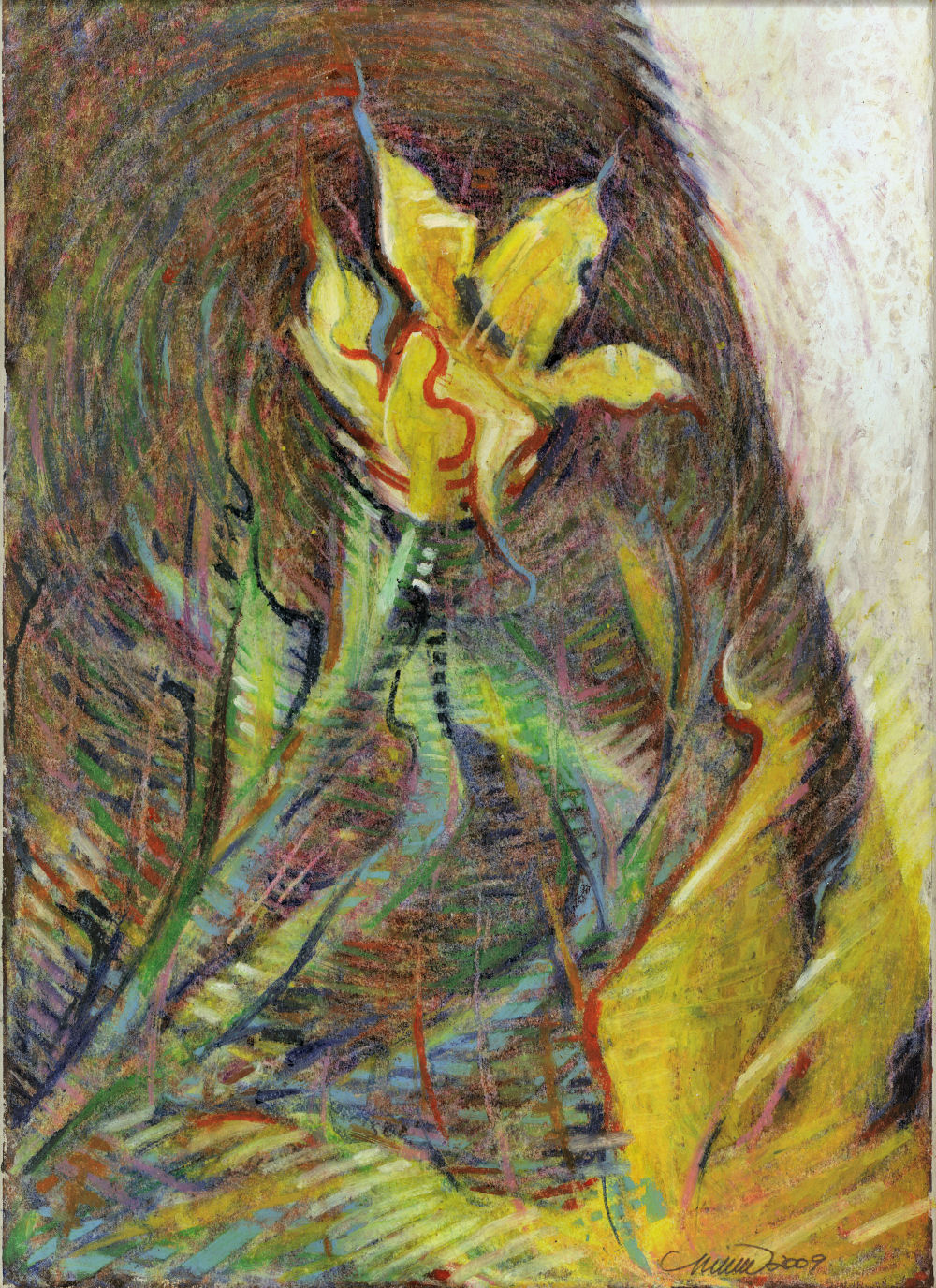
Finished today: added some life to End of Tulip Season, 14H x 11W oil pastels on paper.
Images of progress
Except for the fact that paper has a limit to how much it can be reworked before it starts stretching, I could keep revising these drawings in the Paper Places series continually! Some of them are finished in a day, and truly finished. Some drawings seem OK when they are finished, but have areas that are not quite there yet, so they are left for a month or a year or two then taken out and reworked. It’s great exercise playing with color and composition. Some are taken too far, but with regard to learning, effort is never wasted. Change characterizes this series too; change of place, change of time, change of styles, changing what’s already been changed.
Method reflected by purpose
Friday, January 30th, 2009
 Left: Hemlocks, Queen Charlotte Island, 1980 – 48 x 48 x 2 inches
Left: Hemlocks, Queen Charlotte Island, 1980 – 48 x 48 x 2 inches  acrylics on canvas, painted plein air. Right: Birch, 1993 – 6 x 4 watercolors. I have been trying to return to the same carefree approach I painted with during the earlier years. While some of my first paintings were a little on the sloppy side, the look and feeling of life in the work comes through the first reactive sloppy-looking brushstrokes. Too much refining tones down that energy. It has taken about six years to rid myself of a lot of habits that developed by painting murals, like tidying up too much and mixing colors on the palette as opposed to just throwing the color onto the canvas. Not that mural painting is valued as less than canvas paintings, but they require entirely different methods, and because their intended purpose is slightly different, so is the approach to painting them. Switching back to canvas now, even if the surface is large it’s taken six years to re-adapt to the process of painting on canvas. All that I think I know can get in the way sometimes. In Dancing With Trees 03 I’m rediscovering some of the joy that pushed everything forward in the first place. Virginia, you say that this sings and dances…well, that’s exactly how I feel while painting this one.
acrylics on canvas, painted plein air. Right: Birch, 1993 – 6 x 4 watercolors. I have been trying to return to the same carefree approach I painted with during the earlier years. While some of my first paintings were a little on the sloppy side, the look and feeling of life in the work comes through the first reactive sloppy-looking brushstrokes. Too much refining tones down that energy. It has taken about six years to rid myself of a lot of habits that developed by painting murals, like tidying up too much and mixing colors on the palette as opposed to just throwing the color onto the canvas. Not that mural painting is valued as less than canvas paintings, but they require entirely different methods, and because their intended purpose is slightly different, so is the approach to painting them. Switching back to canvas now, even if the surface is large it’s taken six years to re-adapt to the process of painting on canvas. All that I think I know can get in the way sometimes. In Dancing With Trees 03 I’m rediscovering some of the joy that pushed everything forward in the first place. Virginia, you say that this sings and dances…well, that’s exactly how I feel while painting this one.
Dancing With Trees 03 work in progress, 85H x 45W x 3D inches acrylics on canvas, sides painted
Salish Spindle Whorl Chair finished
Saturday, December 20th, 2008
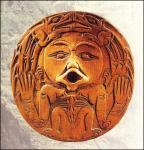 About the chairs: Art on Art on Art – A Tribute to Creativity
About the chairs: Art on Art on Art – A Tribute to Creativity
Each functional, comfortable 29 x 29 x 29 inch replica of ancient Art or artifact re-utilizes vintage plastic lawn chairs that were considered Art during the 1960’s. The original structures, damaged or unusable were refurbished by a process of weaving canvas strips along with white glue paper-mache style over the entire plastic top and bottom, and multiple layers of drywall compound sanded in between coats. Designs are drawn with graphite, painted with acrylics and a few coats of varnish for durability, then waxed to finish and enrich the colors. Two more Solaire chairs and other styles of chairs are in various stages of completion yet to be embellished with historic Art themes from other cultures. Other styles of chairs are also in progress.
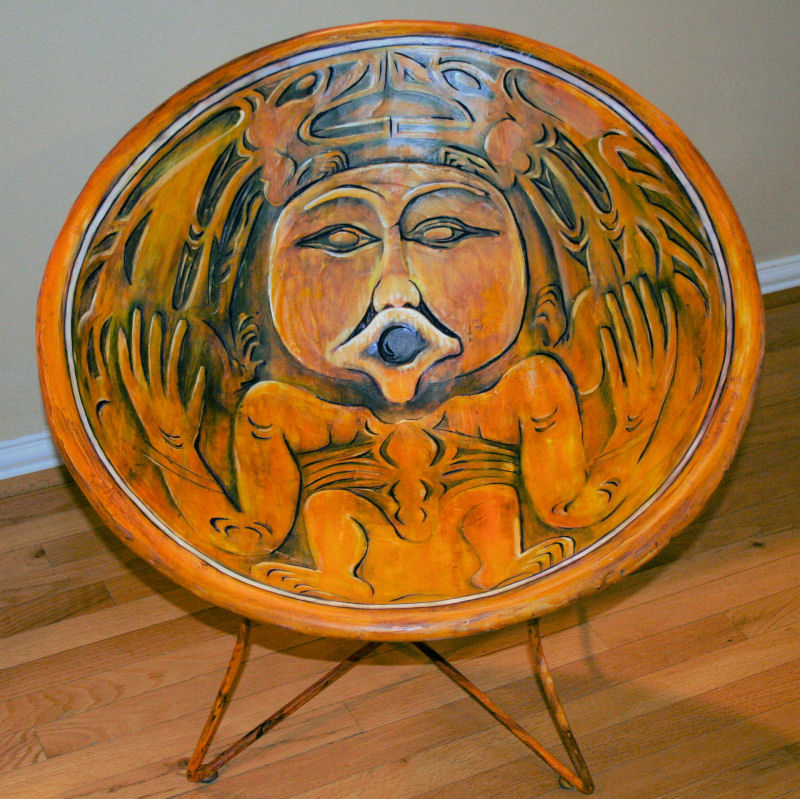 The skeletal structure of these chairs, called Solaire chairs, were manufactured during the 1960s and 1980s. Art in their own day, these particular ones were unusable; in poor condition they were bound for the landfill sight. Originals designed by Fabiano and Panzini, a French Canadian team, the Solaire chairs are now collectors items, some selling for $500.
The skeletal structure of these chairs, called Solaire chairs, were manufactured during the 1960s and 1980s. Art in their own day, these particular ones were unusable; in poor condition they were bound for the landfill sight. Originals designed by Fabiano and Panzini, a French Canadian team, the Solaire chairs are now collectors items, some selling for $500.
The first chair to be up-cycled was a large replica of a Mayan bowl. The Mayan culture (Mexico, Guatemala, Belize and parts of Honduras, 900 B.C. – 900 A.D. Common Era) developed a very complex written language using pictographs. Many of these were facial expressions and hand gestures. The bowl displays the birth of the Maize God, and along the top edge the name of the bowl’s owner is written, as well as possibly what it was used for.
Salish Carved Wood Whorl
 Whorls are weights that stabilize used for spinning yarn. The yarn in this case would have been wound just above the whorl. Spinning yarn and weaving fabric are some of humankind’s oldest technology. Left: example of a spindle with whorl, Eve Spinning Illuminated Manuscript c. 1170 A.D.
Whorls are weights that stabilize used for spinning yarn. The yarn in this case would have been wound just above the whorl. Spinning yarn and weaving fabric are some of humankind’s oldest technology. Left: example of a spindle with whorl, Eve Spinning Illuminated Manuscript c. 1170 A.D.
Historically everywhere wood has been used for tools, utensils and everyday items, they were often carved. The original spindle whorl that was the inspiration for this chair was used by a Salish Northwest Pacific coast community living south and east of Vancouver Island. Here a central human figure holds two otters. A Kwakiutl (also living in Vancouver Island territory) prayer to a Cedar tree prayer was very much a part of the inspiration for this chair. It reads: “Look at me friend! I come to ask you for your dress, since there is nothing you cannot be used for. I come to beg you for this, Long-life maker”.
December 18th: Finishing details, further definition with acrylics and two coats of varnish, waxed. Decided against the decoupage of the Kwakiutl prayer to a Cedar tree because it does not look as good as hoped. December 16th: Carved the plaster in areas then inlaying purple for contrast rather than black. Purple glazes also make yellows much richer.
The back and under-side of the chair is painted to look carved. The undercoat of yellows shines through succeeding layers, and carved wood textures are created with varnish leaving raised brushstrokes, and am trying whatever else I can think of to make it look like wood! More modeling with plaster and light sanding, then redrawing with graphite, and the design is continually adjusted.


